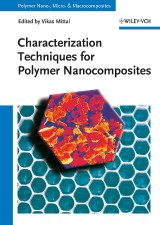Details

Characterization Techniques for Polymer Nanocomposites
Polymer Nano-, Micro- and Macrocomposites, Band 5 1. Aufl.
|
CHF 142.00 |
|
| Verlag: | Wiley-VCH |
| Format: | |
| Veröffentl.: | 24.04.2012 |
| ISBN/EAN: | 9783527654536 |
| Sprache: | englisch |
| Anzahl Seiten: | 378 |
DRM-geschütztes eBook, Sie benötigen z.B. Adobe Digital Editions und eine Adobe ID zum Lesen.
Beschreibungen
With its focus on the characterization of nanocomposites using such techniques as x-ray diffraction and spectrometry, light and electron microscopy, thermogravimetric analysis, as well as nuclear magnetic resonance and mass spectroscopy, this book helps to correctly interpret the recorded data. Each chapter introduces a particular characterization method, along with its foundations, and makes the user aware of its benefits, but also of its drawbacks.<br> As a result, the reader will be able to reliably predict the microstructure of the synthesized polymer nanocomposite and its thermal and mechanical properties, and so assess its suitability for a particular application.<br> Belongs on the shelf of every product engineer.
CHARACTERIZATION OF NANOCOMPOSITE MATERIALS: AN OVERVIEW<br> Introduction<br> Characterization of Morphology and Properties<br> Examples of Characterization Techniques<br> <br> THERMAL CHARACTERIZATION OF FILLERS AND POLYMER NANOCOMPOSITES<br> Introduction<br> TGA of Fillers<br> TGA of Polymer Nanocomposites<br> DSC of Fillers<br> DSC of Composites<br> <br> FLAME RETARDANDY CHARACTERIZATION OF POLYMER NANOCOMPOSITES<br> Introduction<br> Types of Flame Retardant Nanoadditives<br> Thermal, Flammability, and Smoke Characterization Techniques<br> Thermal and Flame Retardancy of Polymer Nanocomposites<br> <br> PVT CHARACTERIZATION OF POLYMERIC NANOCOMPOSITES<br> Introduction<br> Components of Polymeric Nanocomposites<br> Pressure-Volume-Temperature (PVT) Measurements<br> Derivatives;<br> Compressibility and Thermal Expansion Coefficient<br> Thermodynamic Theories<br> Thermodynamic Interaction Coefficients<br> Theoretical Predictions<br> Summary and Conclusions<br> <br> FOLLOWING THE NANOCOMPOSITES SYNTHESIS BY RAMAN SPECTROSCOPY AND X-RAY PHOTOELECTRON SPECTROSCOPY (XPS)<br> Nanocomposites Based on POSS and Polymer Matrix<br> Raman and XPS Applied in Synthesis of Nanocomposites Based on Carbon Nanotubes and Polymers<br> <br> TRIBOLOGICAL CHARACTERIZATION OF POLYMER NANOCOMPOSITES<br> Introduction<br> Tribological Fundamentals<br> Wear Experiments<br> Selection Criteria<br> Design of Polymer Nanocomposites and Multiscale-Composites<br> Selected Experimental Results<br> <br> DIELECTRIC RELAXATION SPECTROSCOPY FOR POLYMER NANOCOMPOSITES<br> Introduction<br> Theory of Dielectric Relaxation Spectroscopy<br> PVDF/Clay Nanocomposites<br> PVDF/BaTiO3 Nanocomposites<br> PVDF/Fe3O4 Nanocomposites<br> Comparative Analysis of PVDF Nanocomposites<br> Conclusions<br> <br> AFM CHARACTERIZATION OF POLMYER NANOCOMPOSITES<br> Atomic Force Microscope (AFM)<br> Elasticity Measured by AFM<br> Example Studies<br> Conclusion<br> <br> ELECTRON PARAMAGNETIC RESONANCE AND SOLID-STATE NMR STUDIES OF THE SURFACTANT INTERPHASE IN POLYMER-CLAY NANOCOMPOSITES<br> Introduction<br> NMR, EPR and Spin Labeling Techniques<br> Characterization of Organically Modified Layered Silicates<br> Characterization of Nanocomposites<br> Conclusion<br> <br> CHARACTERIZATION OF RHEOLOGICAL PROPERTIES OF POLYMER NANOCOMPOSITES<br> Introduction<br> Fundamental Rheological Theory for Studying Polymer Nanocomposites<br> Characterization of Rheological Properties of Polymer Nanocomposites<br> Conclusions<br> <br> SEGMENTAL DYNAMICS OF POLYMERS IN POLYMER/CLAY NANOCOMPOSITES STUDIED BY SPIN-LABELING ESR<br> Introduction<br> Spin-Labeling: Basic Principles<br> Exfoliated Poly(methyl acrylate) (PMA)/Clay Nanocomposites<br> Intercalated Poly(ethylene oxide) (PEO)/Clay Nanocomposites<br> Conclusions<br> <br> CHARACTERIZATION OF POLYMER NANOCOMPOSITE COLLOIDS BY SEDIMENTATION ANALYSIS<br> Introduction<br> Materials and Experimental Methods<br> Results and Discussion<br> Conclusions<br> <br> BIODEGRADABILITY CHARACTERIZATION OF POLYMER NANOCOMPOSITES<br> Introduction<br> Methods of Measuring Biodegradation<br> Standards for Biodegradation<br> Biodegradable Nanocomposites<br> Starch Nanocomposites<br> PCL Nanocomposites<br> PHA/PHB Nanocomposites<br> Nanocomposites of Petrochemical Based Polymer<br> Conclusions
<b>Vikas Mittal </b>is an Assistant Professor at the Chemical Engineering Department of The Petroleum Institute, Abu Dhabi. He obtained his PhD in 2006 in Polymer and Materials Engineering from the Swiss Federal Institute of Technology in Zurich, Switzerland. Later, he worked as Materials Scientist in the Active and Intelligent Coatings section of SunChemical in London, UK and as Polymer Engineer at BASF Polymer Research in Ludwigshafen, Germany. His research interests include polymer nanocomposites, novel filler surface modifications, thermal stability enhancements, polymer latexes with functionalized surfaces etc. He has authored over 40 scientific publications, book chapters and patents on these subjects.
The book series "Polymer Nano-, Micro- and Macrocomposites" provides complete and comprehensive information on all important aspects of polymer composite research and development, including, but not limited to synthesis, filler modification, modeling, characterization as well as application and commercialization issues. Each book focuses on a particular topic and gives a balanced in-depth overview of the respective subfield of polymer composite science and its relation to industrial applications. With the books the readers obtain dedicated resources with information relevant to their research, thereby helping to save time and money.<br> <br> With its focus on the characterization of nanocomposites using such techniques as x-ray diffraction and spectrometry, light and electron microscopy, thermogravimetric analysis, as well as nuclear magnetic resonance and mass spectroscopy, this book helps to correctly interpret the recorded data. Each chapter introduces a particular characterization method, along with its foundations, and makes the user aware of its benefits, but also of its drawbacks. As a result, the reader will be able to reliably predict the microstructure of the synthesized polymer nanocomposite and its thermal and mechanical properties, and so assess its suitability for a particular application.<br>
Diese Produkte könnten Sie auch interessieren:

The History, Use, Disposition and Environmental Fate of Agent Orange

von: Alvin Lee Young

CHF 118.00















